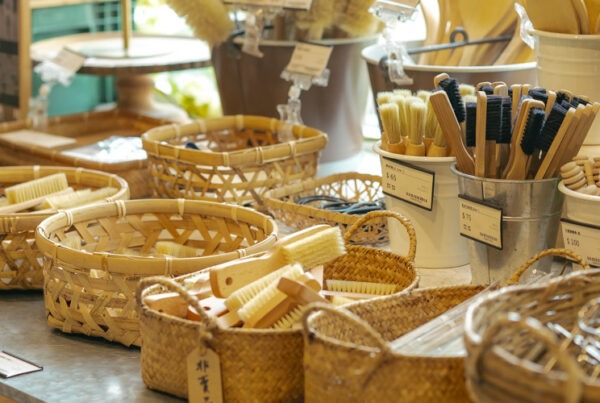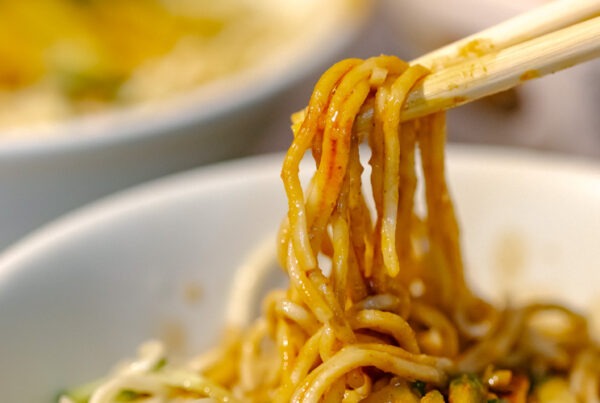How to Make the Most of a Day Up in Maokong
TEXT / AMI BARNES
PHOTOS / VISION
For Taipei-based hiking enthusiasts, it’s almost impossible to go wrong with a trip to Maokong. Convenient transport links and a hilly terrain converge to make the area an ideal quick getaway from the city center, while the local tea-growing heritage has blessed it with photogenic farmland and an abundance of teahouses – and cafés – ideal for rest and refueling.
Note: This article was published in the 2024 Summer Edition of TAIPEI magazine, a publication by the Taipei City Government.
Located on the slopes of Taipei’s Wenshan District in the city’s southeast corner, the most stylish way to reach Maokong is by the Maokong Gondola (www.gondola.taipei). The 25min, 4km ride whisks you over a dense green canopy and through tendrils of low-lying clouds as your carriage soars towards the terminal stop, Maokong Station. Those who aren’t fond of heights can take a bus instead (the BR15 from MRT Taipei Zoo Station is the most frequent; this is also the starting point for the gondola run), and anyone with a surplus of energy can hike up from nearby National Chengchi University (NCCU) by following the Huanshan 2nd Road and Feilong (Flying Dragon) Trail.

Maokong’s hills are ribboned with hiking trails, which vary in difficulty from easy to “I’m-going-to-be-sore-tomorrow.” So, once you’ve picked your preferred mode of transport and have arrived, the next challenge is settling on a trail that suits the time of day and/or year, as well as your interests and/or time constraints. In spring, cherry, peach, and apricot blossoms provide a visual treat in conjunction with short, easy strolls along the Camphor Tree Trail or around the grand grounds of Zhinan Temple. In wintertime, the sweetly perfumed Osmanthus Trail offers olfactory gratification. And year-round, you’ll find students burning the midnight oil with a quick postsunset jaunt up into the hills to watch the city lights blink and sparkle from roadside pavilions, cafés, or teahouses.
Those seeking a more vigorous challenge can set their sights on the Houshanyue or Mt. Erge trails – the first of which involves getting your hands dirty on an almost vertical fixed-rope climb – while longer walks into New Taipei City include a descent past the Yinhe (Galaxy) Cave waterfall, and a section of the Taipei Skyline Trail that traverses Bijia Ridge on its way to the streamside village of Shiding.
TEA AND BAMBOO SHOOTS IN MAOKONG Wenshan District, home to the Maokong area, is well known for the cultivation of tea (especially Tieguanyin) and also bamboo shoots (Oldham bamboo). Maokong produces the most bamboo shoots in Taipei City, and its “golden-horn” bamboo shoots are being praised for their high quality. To highlight these two long-established agricultural sectors in the district, each year the Wenshan District Office organizes the Wenshan Tea and Bamboo Shoots Folk Culture Festival, which includes a wide range of activities, such as tea appreciation sessions, tea garden and bamboo grove DIY experiences, as well as a best bamboo shoot contest and a bamboo shoot banquet.
For adventurers who prefer their wanders on the easier end of the spectrum, turning left out of Maokong Station and following the main road (Section 3, Zhinan Road) will carry you to a trio of trails that can be completed without breaking too much of a sweat. Each can be walked independently or, alternatively, you can weave the three into a pleasant 3.5km loop that takes a couple of hours to complete.
Health Trail
First reached is the Health Trail, the entrance to which is located across from the Taipei Tea Promotion Center for Tie Guanyin Tea and Baozhong Tea. Steps zigzag down past tea terraces before diving into the shade of a wooded stream valley. This is the perfect habitat for the Taiwan Whistling Thrush, an endemic species that is often heard but seldom seen. These shade-loving, blue-feathered sprites flit from one shadowy nook to another, their piercing trill easily distinguishable above the calming gurgle of running water.

Following the stream’s course, you’ll soon arrive at a junction. Turning right here would result in a shorter, less effort-intensive walk, returning up toward Zhinan Road. However, if time and energy levels permit, those who turn left will be rewarded for their exertion. This longer route descends on a raised wooden walkway through bamboo.
From the lower end of the Health Trail, near the Zhinan Stream valley’s bottom, it’s a short walk along a side road to pick up the start of the next path. This is the Tea Center Trail, and you’ll see signage indicating that this route will take you toward the Maokong Potholes. Climbing gently at first, the trail takes you past a waterfall – steps beside the path leading down to the foot of the falls for a better view.

The next section is the steepest ascent of the whole loop (you’re headed back up the side of the valley you just came down), but it’s mercifully short. After a 10-minute climb to the top of this section’s steps, a blink-and-you’llmiss-it side trail extends for 10 meters, terminating at a diminutive red and gold Land God shrine that houses a rock clad in godly regalia.

The walkway thereafter meanders through fields of bamboo, brightened by depictions of farmers tending to their crops, then at a crossroads, another side trail leads down to the potholes. Surveying the streambed from a springy rope bridge, you’ll see circular depressions scoured out by a combination of eddying currents, waterborne gravel, and time. They are said to resemble scratch marks left by an oversized feline, and some claim them to be the origin of the name “Maokong,” which character-for-character could be translated to mean “cat hollow,” although others think the name refers to a valley once teeming with civets.



Heading back up to the previous junction, a left turn will put you on the Pothole Trail, which leads up through more tea terraces and a garden full of water irises until you arrive back on the main road. From there, hook a right, and you’ll soon find yourself walking along the Mini Skywalk. This last and easiest trail follows the road back to the Tea Promotion Center, offering occasional views of the distant city center along the way.



In addition to gentle wanders, Maokong is best known for having a preponderance of teahouses and cafés, many of which stay open into the wee hours to allow guests to take in the night views as they sip on their beverage of choice.
Elsewhere Café – Night Owl Branch
One such haunt is the artsy Elsewhere Café – Night Owl Branch located about 250m northwest of the Tea Promotion Center. This establishment offers a small range of savory noodle dishes alongside a more extensive menu of coffees, teas, and cakes – making it ideal for a leisurely post-hike afternoon tea or coffee, or as its name suggests, a midnight getaway for the city’s night owls.

The overall atmosphere is one of an art student common room. Cushions dot the comfy indoor seats, and there are sheltered outdoor areas suited to couples or small groups. Temporary art exhibits adorn the walls, a small store sells postcards and tote bags, and a row of shelves holds dogeared graphic novels for guests to take to their tables. Cats roam the premises, draping themselves over walkways and lounging beneath chairs, not caring a fig for all the comings and goings of their human coworkers or visitors. As night falls, strings of fairy lights come on to illuminate the leafy garden, and from the top-floor seating you can catch a glimpse of the city far below – just don’t get so comfortable that you miss the last gondola or bus ride down!

Elsewhere Café – Night Owl Branch
生活在他方-夜貓店
Add: 8-5, Ln. 40, Sec. 3, Zhinan Rd., Wenshan Dist.
Hours: Thu. to Sun. 12:00pm-2:00am
IG: instagram.com/elsewherecafe.mao
Lazy Day Cafe
Where Elsewhere Café offers twinkling lights and resident felines, Lazy Day Cafe is all about hanging out in the embrace of Mother Nature. With not a socket in sight, it offers a break from the pressures of the everyday, and visitors who stray off the main road to descend its lamp-lined steps through thick tree cover will find a charmingly unpolished space that feels simultaneously cozily confined and at one with the surrounding greenery.

The café is managed by a husband and wife couple who preside over their little corner of calm with warm hospitality. The wife, in particular, enjoys welcoming guests from all corners of the globe and – when not preparing the home-cooked cakes or dumplings – is on a mission to meet customers from every country (currently, she says the count stands at 60-something). And it’s not just the food that’s produced in-house. The husband is a lifelong Maokong resident from tea-farming stock, so the Tieguanyin tea and honey used for their drinks are sourced from their plot of land.

Drink recommendations include the aforementioned Tieguanyin tea, which is naturally sweet with a slightly floral aftertaste and is served in a nifty teapot resembling a miniature stone rice mill. Other popular picks include the LazyDay blend coffee and osmanthus honey tea.
Lazy Day Café
小日子
Add: Ln. 38, Sec. 3, Zhinan Rd., Wenshan Dist. (about 250 meters southeast of Maokong Station)
Tel: (02) 2301-7070
Hours: Tue. to Fri. 10:00am-7:00pm
Sat. and Sun. 10:00am-8:00pm
FB: www.facebook.com/lazyday
MAOKONG TEA, TAIPEI ZOO, PUBLIC ART If you are interested in learning more about Maokong’s tea production, visiting the Taipei Tea Promotion Center for Tie Guanyin Tea and Baozhong Tea is recommended. The center offers educational programs, guided tours, and tea-tasting sessions. It is open from 9am to 5pm (closed on Monday). If thinking about combining a trip to Maokong with a visit to the Taipei Zoo, note that during July and August the zoo is open until 9pm on Saturdays, giving you more flexibility when planning your day. An area rich in natural and agricultural resources, Maokong also has its share of cultural treasures. In the past two years public-art installations and performances have been presented as part of an ongoing cultural-brand project named Satoyama (www.satoyama-tpe.com). Last year for example, the celebrated Maokong-based performance troupe U-Theatre (www.utheatre.org.tw) gave a memorable performance at Zhinan Temple. The Satoyama events usually take place in November.
About the author













